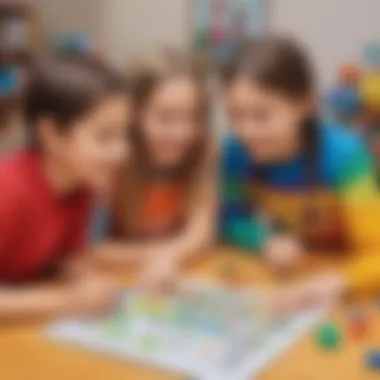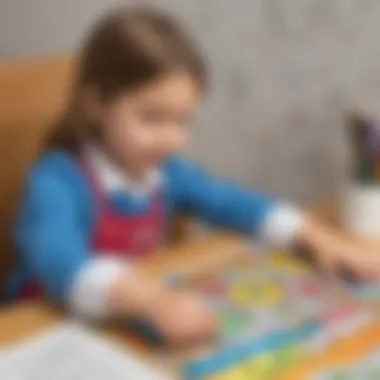Colouring the Game: Enhancing Learning through Interactive Education


Intro
In the landscape of children's education, the integration of vibrant colours and interactive experiences can significantly enhance the learning process. Engaging children aged 3-12 in educational games that incorporate colouring elements fosters not only creativity but also critical thinking skills. This article highlights the myriad benefits of colouring games within educational frameworks. By focusing on how these games align with essential learning objectives, it aims to equip parents and educators with valuable insights to improve children's cognitive development.
Interactive Learning Games
Interactive learning games serve as a medium through which children can explore educational concepts virtually. These games often incorporate colourful graphics and engaging tasks that capture a child's imagination while educating them. By blending play and learning, these games stimulate various cognitive processes, making information retention more effective.
Popular Games
Several educational games have gained popularity among parents and teachers alike. These include:
- Draw and Learn: Enables children to colour various images while learning shapes, numbers, and letters.
- Colour Quest: This game introduces children to art and creativity through interactive colouring challenges that also teach problem-solving skills.
- Artful Learning: Focuses on integrating art activities into academic subjects, encouraging interdisciplinary learning.
Benefits of Playing Educational Games for Kids' Cognitive Development
The cognitive benefits of interactive learning games are profound. Some of these advantages include:
- Improved visual recognition by engaging with colours and patterns.
- Enhanced fine motor skills through tools for colouring and drawing.
- Availability of different scenarios that encourage logical reasoning and critical thought.
- Increased engagement levels resulting in better focus and information retention.
Game Reviews
When assessing educational games, it's essential to consider gameplay alongside learning outcomes. Some noteworthy games evaluated include:
- Draw and Learn: This game received positive reviews for its user-friendly interface and educational value. Many parents report that their children actively participate and show improvements in basic literacy skills.
- Colour Quest: This game not only entertains children but also develops their strategic thinking as they solve puzzles to advance levels. The vibrant colours and engaging tasks keep children motivated.
- Artful Learning: Teachers who've incorporated this game into their curriculum find it an effective way to make subjects like science and math more relatable.
Research shows that children immersed in interactive games learn better and retain information longer than traditional teaching methods.
Comparison of Gameplay and Learning Outcomes
To facilitate informed decisions among parents and educators, comparing gameplay experiences alongside learning benefits is beneficial. For instance, games that require active participation are more effective in promoting critical thinking than those with passive engagement. This distinction helps in selecting the right tools to support the educational journey of children.
Educational Topics
The world of children's education encompasses various subjects, including literacy, mathematics, science, and the arts.
Importance of Interdisciplinary Learning for Holistic Development
An interdisciplinary approach in education allows children to see connections across different subjects. It helps them understand that knowledge is not compartmentalized but interconnected. For example, integrating math into art can enhance spatial reasoning while fostering artistic expression. This method nurtures a well-rounded intellect in children.
Tips and Tricks
Parents and educators often seek innovative ways to keep children engaged in learning. Here are practical strategies:
- Incorporate Colouring: Use colouring activities that coincide with teaching subjects.
- Set Goals: Create small, achievable learning goals that motivate children to complete tasks in games.
- Encourage Discussion: Facilitate conversations about the game content to deepen understanding.
Creative DIY Projects
Hands-on activities not only nurture creativity but also enhance cognitive and motor skills.
Step-by-Step Guides
Engaging DIY projects can be a fun way to support learning. Here is a simple guide:
- Gather Materials: Collect paper, colouring supplies, and everyday items from home.
- Design a Theme: Choose a theme like animals or seasons to base your project.
- Create Together: Work alongside children to develop the project, encouraging their input and creativity.
Craft Ideas
Creating art simply requires imagination. A collection of craft ideas includes:


- Making greeting cards using drawings and stickers.
- Crafting a mobile by hanging coloured shapes from a wire.
- Building models from recyclable materials and decorating them with paint.
These activities not only spark creativity but are also beneficial for the child's overall development.
Preamble to the Importance of Colour in Education
In today's educational landscape, the significance of colour is often understated. However, it is essential to recognize how colour influences learning experiences, particularly for children. The use of varied colours can enhance engagement and understanding, creating a stimulating environment for learners aged 3-12. This demographic benefits immensely from vibrant visuals that capture their attention and stimulate their imagination.
Studies show that colour plays a crucial role in emotional responses. When children interact with different hues, they can develop a sense of attachment or aversion, which can affect their willingness to learn. For instance, softer tones tend to create a calm atmosphere, while bright colours can evoke excitement and energy. Therefore, by thoughtfully incorporating colour into educational activities, parents and educators can significantly impact children's motivation and interest in learning.
Moreover, colour can serve as a practical tool in categorization and memory. Children can better comprehend and retain information when concepts are associated with specific colours. This not only aids recall but also helps in distinguishing between different subjects and ideas. In essence, understanding the importance of colour in education forms the foundation for developing effective learning strategies.
The Psychological Impact of Colour
The psychological effects of colour are profound and can influence mood, motivation, and behaviour. Research indicates that particular colours can evoke specific feelings in children. For example, blue is often associated with calm and stability, while red tends to invoke excitement and urgency.
When children engage with colour in educational settings, the blend of colours can create an optimal learning environment. The right palette can lead to increased focus and improved retention of information. As they colour or interact with educational materials, they are not just participating in an activity, but also subconsciously responding to the emotional cues present in their surroundings.
Colour's Role in Cognitive Development
Colour plays an integral part in cognitive development by supporting various learning processes. Younger children often learn about shapes, letters, and numbers through colour distinctions. When they associate specific colours with certain shapes or letters, they enhance their pattern recognition abilities. This connection can lay a solid groundwork for more complex learning tasks as they grow.
In addition, colour helps children to develop critical thinking skills. They learn to make choices based on colour preferences, which can lead to discussions about personal likes and dislikes. These choices encourage children to express their opinions and justify their reasoning, promoting higher-level thinking. Colouring, therefore, is much more than a playful activity; it is a means to enrich cognitive skills and provide critical developmental support.
Types of Colouring Games for Children
Understanding the types of colouring games available for children is essential for promoting their learning and development. Each style of colouring game offers unique benefits and caters to different aspects of a child’s growth. This section delves into three primary categories: digital colouring applications, traditional colouring books, and interactive colouring activities. Each type presents opportunities for engagement and creativity, making them valuable tools in educational settings.
Digital Colouring Applications
Digital colouring applications represent a modern evolution in creative expression for children. These applications are interactive and often feature engaging interfaces that can draw children in quickly. Benefits of digital colouring include:
- Accessibility: Children can access a wide range of colours and tools at their fingertips.
- Variety of Content: Many applications offer themed content, which can align with seasonal events, educational topics, or popular characters.
- Save and Share Capabilities: Children can save their creations and share them with family and friends, fostering encouragement and validation.
- Adaptive Learning: Some apps provide features that adapt to a child’s skill level, promoting gradual improvement in their artistic abilities.
Overall, digital colouring applications can motivate young learners and provide a sense of ownership over their creative output, harnessing technology to enhance their educational experience.
Traditional Colouring Books
Traditional colouring books have long been a staple in childhood education. These books are simple, yet they offer profound benefits. The tactile experience of colouring with crayons, markers, or coloured pencils can develop fine motor skills in young children. Important aspects include:
- Reduced Screen Time: Encouraging children to use traditional materials helps to limit their exposure to screens, which is increasingly relevant in a digital world.
- Focus on Memory and Imagination: Colouring from a physical book allows children to use their imagination to fill in the spaces, stimulating their memory.
- Social Interaction: Colouring books can be shared among peers, providing opportunities for cooperative play and learning.
- Variety in Theme and Complexity: From simple shapes to intricate designs, traditional books can cater to various age groups and skill levels.
In this way, traditional colouring books remain a powerful pedagogical tool, promoting not just creativity but also social skills and cognitive development.
Interactive Colouring Activities
Interactive colouring activities combine physical and social elements to foster collaborative learning. These may include group projects, community art installations, or guided workshops. Some key considerations for these activities are:
- Team Building: Engaging in group colouring fosters teamwork as children collaborate on projects.
- Cultural Awareness: Themes can introduce children to world cultures, allowing them to explore colour significance in different societies.
- Incorporation of Other Skills: Often, these activities can blend in other subjects such as math (measuring areas for larger projects) or science (discussing colours in nature).
- Hands-On Learning: The act of engaging in tangible projects helps solidify concepts through action.
Interactive colour activities enrich the learning experience by harnessing the power of collaboration and hands-on engagement.
By understanding these types of colouring games, parents and educators can tailor activities that best suit a child’s developmental needs, helping them thrive through creativity.
In summary, the variety of colouring games available to children each serve specific developmental purposes. Choosing the right type can enhance learning and enrich the educational journey.
Integrating Colouring into Educational Frameworks
Integrating colouring into educational frameworks is essential for promoting a holistic approach to learning. Colouring activities create an interactive platform that can complement traditional teaching methods. These activities not only captivate children's attention but also enhance their understanding of academic subjects. By incorporating colouring into various subjects, educators can boost engagement and retention among students. One must consider how these activities align with learning objectives and the broader educational goals.
Linking Colouring to Academic Subjects


When discussing educational frameworks, it's crucial to connect colouring activities with core academic subjects. This integration can foster deeper learning and comprehension.
Math
Colouring can play a significant role in math education. For instance, children can use colour to represent different numerical values or geometric shapes. This visual representation makes abstract concepts tangible. The key characteristic of math is its foundational role in problem-solving and critical thinking. Activities such as colouring shapes or patterns can help kids grasp basic arithmetic skills. The unique feature of math integration through colouring is that it appeals to visual learners. However, relying solely on colour may sometimes oversimplify complex ideas, requiring balance in instructional strategies.
Science
The connection between colouring and science is notable as well. Colouring can be used to illustrate biological processes, chemical reactions, or environmental themes. This characteristic makes science an engaging subject for children who might find it otherwise challenging. Colouring activities can help evoke curiosity to explore natural phenomena. The unique feature of science in educational colouring is the ability to create vivid visuals of intricate systems. A disadvantage is that it might not capture the full complexity of scientific concepts. Therefore, educators should combine colouring with hands-on experiments for a comprehensive understanding.
Language Arts
In language arts, colouring can aid in developing literacy skills. Children can colour illustrations that accompany stories, which enhances comprehension and retention. The characteristic of language arts focusing on communication aligns well with creative expression through colour. This makes it a popular choice for integrating colouring. A unique aspect is the personal connection children build with narratives, as colouring can reflect their interpretation of the text. A limitation, however, may arise from emphasizing colour over other artistic methods, potentially narrowing creative pathways.
Developing Critical Thinking through Colour Choices
Colour choices during activities promote critical thinking. Children learn to make decisions about which colours to use, which helps them articulate their preferences and understand the implications of their selections. This process fosters observation skills and encourages them to think outside the box. Through this exploration, young learners develop problem-solving abilities, as they start to connect colours with various emotional and contextual meanings.
"The ability to choose and explore colours reinforces cognitive development in children."
Engaging children in discussions about their colour choices further enhances their analytical skills. For example, a child can be asked why they chose a specific shade for a character, prompting them to think critically about their decisions.
The Benefits of Colouring Games in Learning
The inclusion of colouring games in educational approaches holds significant value. These activities do more than just entertain children; they serve as powerful tools for enhancing various fundamental skills. As children engage in colouring, they are not simply filling in pictures; they are participating in multi-dimensional learning processes. The benefits of colouring games stretch across the realms of creativity, fine motor skill development, and social interaction.
Fostering Creativity
Colouring games provide a unique platform for creativity. When children choose colours and create their images, they tap into their imaginative capabilities. Unlike traditional learning methods that often follow structured pathways, colouring allows for freedom of expression. This freedom is essential for creativity. It encourages children to think outside the box and explore various colour combinations, leading to personal satisfaction in artistry.
Moreover, creativity impacts critical thinking. When a child makes choices about their artwork, they engage cognitive functions that are necessary for problem-solving. In connection with educational outcomes, fostering creativity through these games can contribute positively to other areas of learning and development in children.
Enhancing Fine Motor Skills
The act of colouring inherently requires fine motor coordination. As children use crayons, markers, or paint, they develop hand-eye coordination and dexterity. These skills are vital as they play a crucial role in many day-to-day activities, such as writing, buttoning clothes, and using utensils.
In addition, colouring activities can also improve grip strength. For instance, holding a crayon appropriately helps conditions the hand muscles, making it easier for tasks that require precision.
The following are fine motor skills increaced through colouring:
- Holding writing instruments properly
- Controlling pressure when drawing or colouring
- Following lines and shapes on paper
Promoting Social Interaction
Colouring games can also serve as a medium for social interaction. When children engage in these activities together, whether in a classroom or at home, they naturally begin to communicate. This interaction fosters relationship-building and cooperative learning.
Children learn to share materials, offer constructive feedback on each other's work, and even collaborate on joint projects. These experiences lay the foundation for social skills that are critical throughout life.
"Engagement in creative play is not just about fun; it builds essential life skills."
Strategies for Parents and Educators
Integrating colouring activities into education requires strategic planning. Parents and educators play a crucial role in maximizing the benefits of these interactive activities. The correct approach can greatly enrich children's learning experiences. By focusing on thoughtful strategies, they can ensure that colouring enhances creativity, cognitive skills, and social interactions.
Selecting Appropriate Colouring Resources
Choosing the right resources is the first step for parents and educators. Various materials are available to cater to different age groups and learning preferences. Here are some factors to consider when selecting colouring resources:
- Age Appropriateness: Ensure the complexity matches the child's developmental stage. Younger children benefit from simpler designs, while older kids can handle more intricate patterns.
- Educational Value: Look for colouring books and apps that correlate with academic subjects like mathematics, science, or literature. They should include themes that can spark discussion or further exploration.
- Diversity of Choices: A broad selection of colouring resources can cater to different interest areas. This variety may include nature, space, or cultural themes, promoting both learning and creativity.
Additionally, consider opting for materials like washable markers or eco-friendly crayons to encourage creativity while being mindful of safety and environmental impact. By choosing the right resources, parents and educators provide a strong base for creative expression and learning.


Creating a Colour-Friendly Learning Environment
A conducive environment enhances the impact of colouring activities. The space where children engage in these activities should be inviting and stimulating. Here are ways to create a colour-friendly environment:
- Designated Art Space: Establish a specific area for colouring to promote focus. This space can be adorned with various coloured items and examples of children's work, fostering inspiration.
- Access to Materials: Ensure that colouring supplies are readily available. Stock a variety of items including crayons, coloured pencils, and markers to encourage spontaneous creativity.
- Positive Reinforcement: Celebrate children's artistic efforts. Display their work prominently to instill confidence and encourage continual participation in creative tasks.
With a well-thought-out environment, children are more likely to engage deeply in their colouring activities, making it a fruitful educational experience.
Encouraging Exploration and Experimentation
Exploration is essential in learning. Parents and educators should promote a mindset of experimentation in colouring activities. This can lead to innovative thinking and greater enjoyment. Here are strategies to encourage exploration:
- Open-Ended Questions: While children colour, ask questions that stimulate their thought processes. For example, inquire about their choice of colours or what story their artwork tells.
- Diverse Techniques: Introduce various colouring techniques, such as blending, shading, or even using unconventional tools like sponges or brushes. This variation can enhance motor skills and creativity.
- Freedom of Choice: Allow children to choose their own subjects and colour palettes. This autonomy fosters a sense of ownership over their work and can lead to unique creative outcomes.
By cultivating an environment that values exploration, parents and educators can empower children to take risks in their artistic expressions, ultimately enriching their educational experiences.
"Encouragement and freedom in exploration can unlock a child’s potential, transforming painting and drawing into meaningful learning experiences."
In summary, by implementing thoughtful strategies, parents and educators can significantly influence children's learning through colourful activities.
Future Trends in Colouring Educational Games
The world of education is changing rapidly, and so is the role of colouring games within this environment. Understanding future trends in colouring educational games allows educators, parents, and developers to create experiences that are not only engaging but also highly beneficial for young learners. Innovations in technology and a growing awareness of environmental sustainability lead many trends today. These developments enhance the educational value of colour-centric games, making them more interactive and purposeful.
Augmented Reality and Colouring
Augmented reality (AR) presents an exciting avenue for integrating colouring with interactive learning. By merging the digital with the physical, AR can make colouring activities come alive in ways previously unimagined. Children can colour in a page, and through a smartphone or tablet, they can see their creations animated. This feature increases engagement and encourages children to explore their creativity. AR also has the potential to impart educational content. For example, by colouring a specific animal, the AR application might provide facts about that animal's habitat, diet, and behavior. This bridges the gap between artistic expression and academic learning.
Parents and educators should consider the following points regarding AR in colouring games:
- Enhanced Engagement: The interactive elements can hold children's attention better than static images.
- Educational Value: Combining colouring with educational facts enriches the learning experience.
- Skill Development: Children can develop tech skills alongside artistic abilities.
While AR is promising, it is essential to ensure that the content is age-appropriate and not overly stimulating. A balance must be struck between fun and learning.
Sustainable and Eco-Friendly Materials
As awareness regarding environmental issues continues to grow, so does the demand for sustainable and eco-friendly materials in educational games, including colouring products. Parents and educators are increasingly looking for ways to incorporate eco-conscious choices. This trend not only benefits the planet but also teaches kids about sustainability.
Using materials such as recycled paper, soy-based inks, or biodegradable products can significantly reduce the ecological footprint of colouring activities. For instance, some brands now offer colouring books printed on recycled paper with vegetable-based dyes. This aspect can be an educational topic in itself, as children learn why these choices matter.
Consider these benefits of sustainable materials:
- Environmental Awareness: Educating children about sustainability from a young age can foster responsible future citizens.
- Healthier Choices: Eco-friendly materials often have fewer harmful chemicals, ensuring safer play.
- Promoting Innovations: As the market shifts, it encourages creators to innovate in sustainable practices.
In summary, future trends in colouring educational games reflect a strong connection with technology and environmental consciousness. By integrating augmented reality and sustainable materials, these games become enriching platforms that foster creativity while aligning with modern educational priorities.
"The evolution in educational tools helps shape how children understand the world and their role within it."
Embracing these trends can enhance the experience for everyone involved, transforming the way children engage with art and learning.
Culmination: The Potential of Colouring in Education
The role of coloring in education extends far beyond simple enjoyment. It harnesses the innate curiosity of children and channels it into meaningful learning experiences. This article explored various aspects of interactive coloring, revealing its capacity to influence cognitive development positively.
Benefits of Colouring in Learning
Coloring games can foster creativity in children. This creativity allows them to explore their environment, think critically about various choices, and express themselves. By encouraging them to choose colors and patterns, educators can guide children to reflect on their decisions.
Moreover, coloring activities can enhance fine motor skills. As children learn to control their coloring tools, they develop hand-eye coordination and dexterity. These skills are essential not just for art but also for writing and other activities in daily life.
"Interactive learning through coloring activities encourages natural interest, leading to deeper engagement and understanding."
Another benefit is promoting social interaction. Group coloring activities can teach children to share resources and communicate differences in opinions or preferences. This interaction builds their social skills and boosts confidence in expressing ideas.
Considerations for Implementation
For parents and educators, integrating coloring into various subjects is crucial. By linking coloring to topics in math, science, and language arts, the potential of these activities multiplies. When mathematics problems include coloring components, for example, children might visualize solutions more effectively.
Additionally, in a digital age, the emergence of apps and interactive platforms provides opportunities to make coloring accessible and engaging. However, parents should be discerning about the digital tools they choose, ensuring that they are age-appropriate and promote constructive learning.
With the right strategies in place, the contribution of coloring to educational frameworks is likely to grow, enriching the learning landscape for children.















